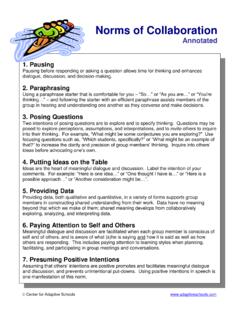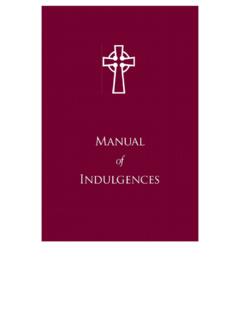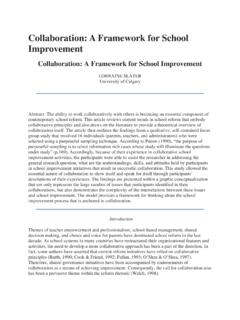Transcription of Conservation of cultural heritage: from participation to ...
1 ENCATC JourNAL of cultural MANAGEMENT ANd PoLICY // Volume 5, Issue 143 Conservation of cultural heritage: from participation to collaborationPetronela SpiridonInstitute for Social & European Studies (ISES), K szeg, Hungary; Alexandru Ioan Cuza University of Iasi ARHEOINVEST Platform, Ia i, Romania Spiridon and Ion SanduAlexandru Ioan Cuza University of Iasi ARHEOINVEST Platform, Ia i, Romania concept of participatory Conservation of cultural heritage involves the investigation of ways in which community members can be encouraged to become active actors and collaborators in the preservation/restoration process of cultural heritage assets and, beyond that, promoters of tourism policies and processes and the cultural , ethnographic and religious values that such assets embody.
2 This paper aims to present some forms of participation in the Conservation of the cultural heritage process as an important part of integrated scientific Conservation management, starting from an important series of documents on international policy in the :Integrated conservationCultural volunteeringConscious degradationCultural policyPETroNELA sPIrIdoN ANd IoN sANdu // Volume 5, Issue 144 IntroductionIn general, the Conservation process aims to valorise cultural and natural heritage assets and to preserve their historical messages (Sandu, 2004). In this regard a series of specific actions, measures, n o r m s , p r i n c i p l e s , s y s t e m s , t e c h n i q u e s a n d intervention methods are undertaken and elaborated, infrastructures that are necessary, respectively, in investigation/research, preservation and restoration, direct or indirect, from the discovery/acquisition/transfer of the assets to their display/recovery/hoarding ( , 2008; Perusini, 2004).
3 Conservation Science, as a new field, is interdisciplinary, complex, global in character, both scientific (theoretical) and technological (practical) and adopts the modern concept of integrated Conservation (Moldovan, 2010). This concept aims to satisfy the dual purpose of preserving and disseminating knowledge about cultural heritage in an integrated way, in close connection with socio-e c o n o m i c a n d c u l t u r a l development at micro and macro level. Out of this grew the concepts of collaborative Conservation and participatory Conservation which focus on stimulating all stakeholders i n v o l v e d i n t h e p r o c e s s ( cultural , social, economic and environmental) and the active involvement of the public and community members (Spiridon, 2013).
4 In this regard, recently the importance has been highlighted of setting up a work team that, in addition to the conservator and the renowned specialists in the field (curator, restorer, etc.), should include representatives f r o m t h e p u r e s c i e n c e s (Geology and Mineralogy, Chemistry, Biology, Applied Science, Environmental Science), from the fields of technology and art history and even the members (artists and local natives) of communities from regions with tangible heritage value (Jo-Fan, 2012; Stoner, 2005). This inter-multidisciplinary collaboration offers support to the conservator in their work, not only providing support to investigate treatment options, find the materials and identify the techniques used by the artists, establish the date of manufacture and investigate the optimal materials (including from the cultural and ethnographic perspectives), but also to provide contextualisation and justification of scientific data through visual inspection and through the results of historical research (oriented to knowledge of the original cultural context) (Spiridon et al, 2013).
5 In general, the state of Conservation of many very old cultural objects is impacted not just by the environment s aggressiveness, but also by domestic and industrial activities and the levels of cultural and environmental education of the people. For this reason the participatory approach investigates ways in which the community members from the regions with tangible heritage value can be motivated to redefine their individual roles and responsibilities consciously and voluntarily (Bass et al, 1995; Brown, 1999; Sandu, 2013).International documents and events in the fieldThe new policies on the approach to cultural heritage consider the safeguarding and inclusion of cultural heritage assets within a global system of values, the development o f c u l t u r a l t o u r i s m a s a w a y o f g u a r a n t e e i n g t h e right of access to culture a n d t h e i n t e g r a t i o n o f active participation of the population in cultural heritage Conservation if the concept of integrated Conservation i s r e l a t i v e l y m o d e r n.
6 T h e attempts to attract members of the public/community to the activities aimed at preserving cultural heritage have a longer history. The role of community in the cultural heritage Conservation process (preservation, restoration, r e c o v e r y a n d h o a r d i n g ) , which imply the concepts of collaborative and participatory Conservation , started in 1964 with the Venice Charter and continued over time through a series of international documents and events, as we can see in table documents and events describe, at the same time, the educational, interactive and public-oriented role of the specialists operating in Conservation Science which can be accomplished by dissemination of information from historiographical research, technical-scientific and artistic investigation, preservation and restoration.
7 By the design and development of educational platforms in the field and by providing advice and technical assistance on cultural heritage (ICOMOS, 1990; Spiridon et al, 2013). even if the concept of integrated Conservation is relatively modern, the attempts to attract members of the public/community to the activities aimed at preserving cultural heritage have a longer history .ENCATC JourNAL of cultural MANAGEMENT ANd PoLICY // Volume 5, Issue 1451 For more information, see participatory Conservation principlesThe fundamental principles that govern the rules applied in the cultural heritage Conservation process are included in specialty literature and scientific practice based on rules, orders, codes of ethics or conduct/laws, decrees, orders and decisions in the field.
8 Until very recently, authenticity, importance of maintenance, minimum intervention, truth and honesty, reversibility, fitting the new to the old, legibility of interventions and monitoring the Conservation status by making regular checks ( , 2008; Worthing & Bond, 2008) were the main principles respected in the general Conservation process (preservation and restoration). Today the focus is on an integrated process of scientific Conservation (participatory Conservation and stakeholder engagement). This approach is proposed by a series of documents and studies in the field, which also suggest a specific set of interdependent principles Yeardocument/eventPoint of interest1964 The Venice CharterStates that the monumental works of the peoples are considered common heritage and it is necessary to safeguard them for future generations in a responsible way so as to hand them on in the richness of their authenticity (ICOMOS, 1964).
9 1972 The Heritage ConventionPromotes a general policy whereby cultural and natural heritage aims to perform an important function in community Lausanne CharterEncourages local community involvement in cultural development (ICOMOS, 1990).2002 The Budapest DeclarationPuts more emphasis on the active involvement of local communities at all levels in the Conservation and management of World Heritage property (UNESCO, 2002).2003 The Intangible Heritage ConventionRequests community participation in the process of Conservation (UNESCO, 2003).2003 Code of Ethics, that the work of preservation/restoration is an activity of public interest and should be conducted in accordance with national and international law ( , 2003).
10 2005 The Faro ConventionRequests greater synergy between public heritage management cultural Heritage Forum organised by Europa Nostra, in collaboration with the European Economic and Social Committee (EESC), Brussels, 2005 The central point of discussion focusses on the active involvement of institutions and individuals in the Conservation of cultural heritage and even on the awareness of the personal benefits that may result from this European Year of VolunteeringA call to action for local administration representatives responsible for cultural and educational policies, trainers from public and private structures, associations and NGOs providing cultural services, and educational professionals from cultural institutions, magna Charta del volontariato per i beni culturali (Velani & Rosati, 2012)





